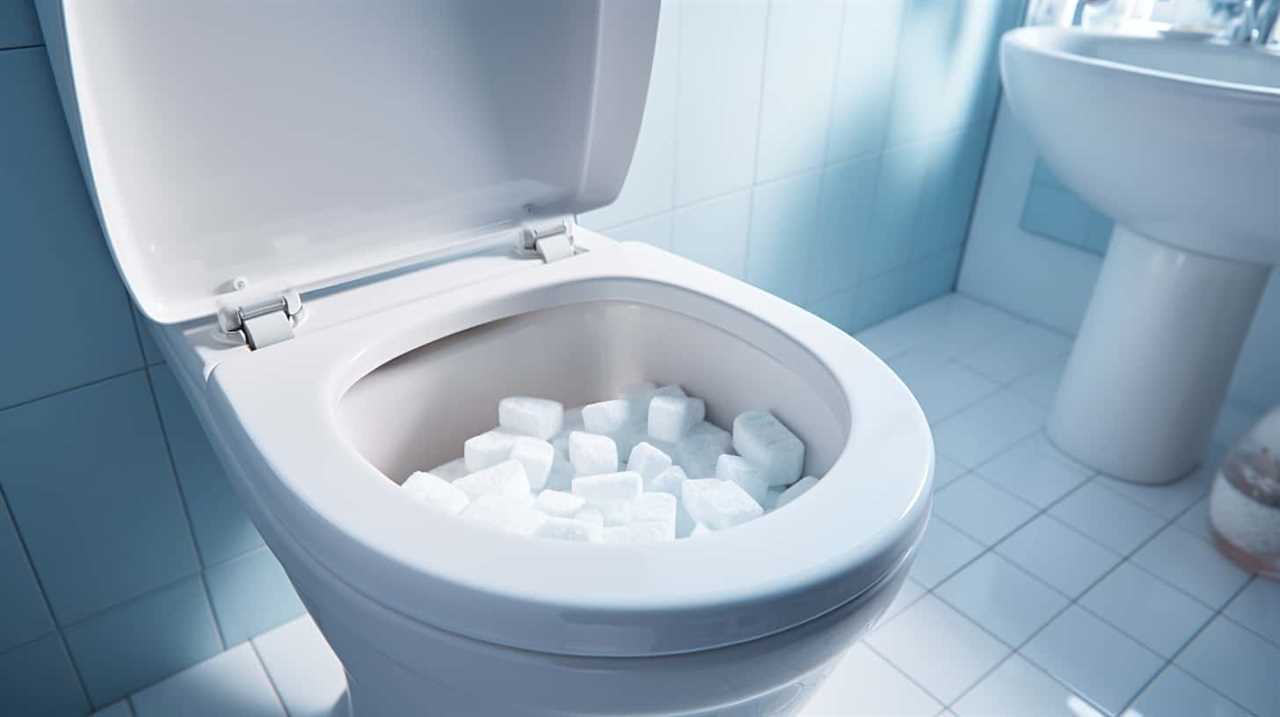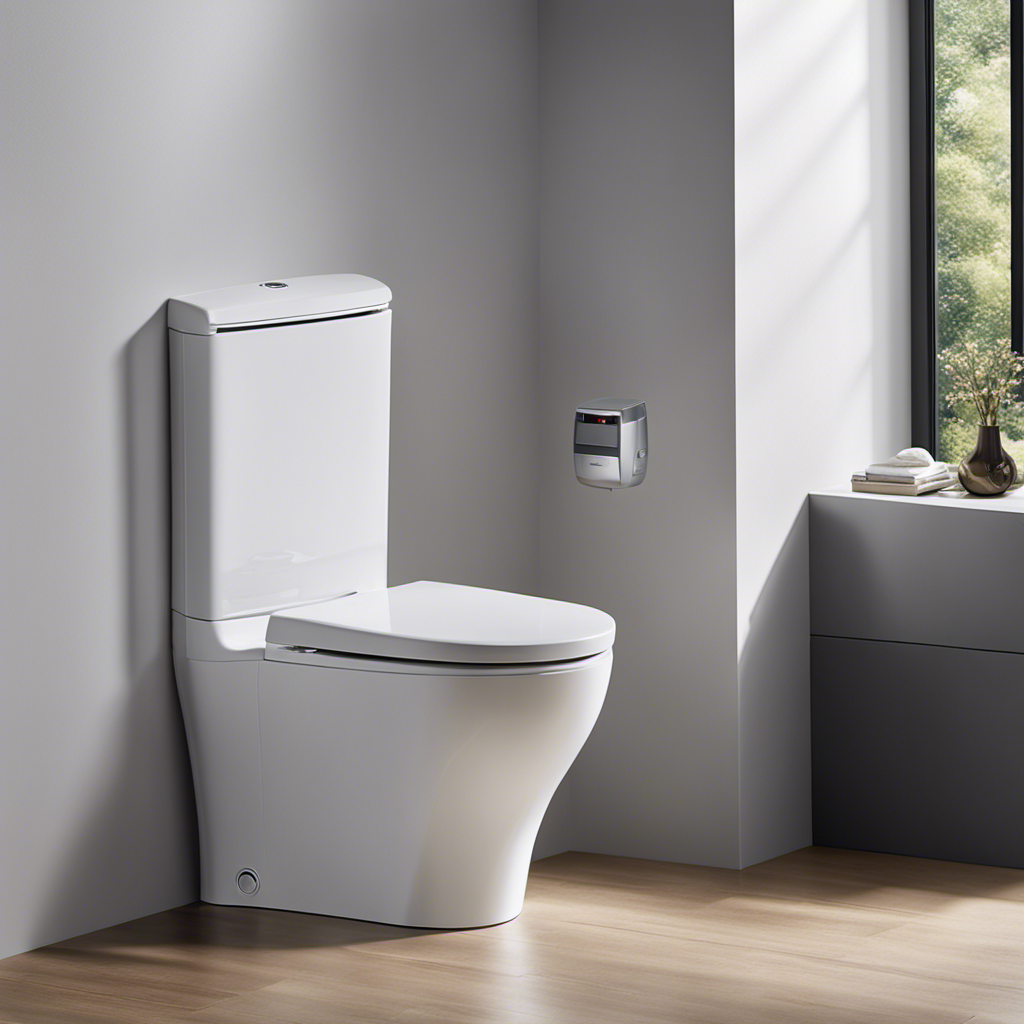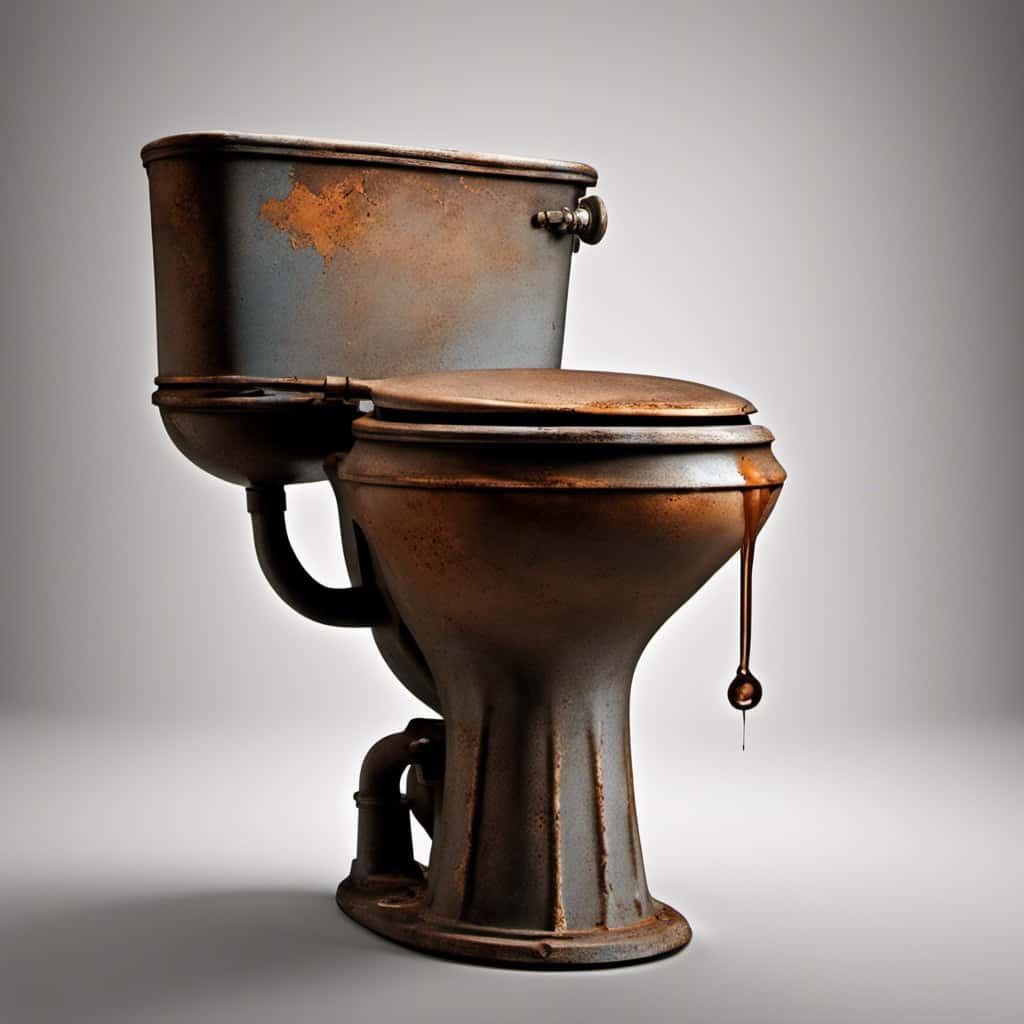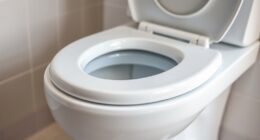Ever been curious about the consequences of flushing tampons down the toilet? Let’s delve into it—it’s far from a pleasant outcome. By ignoring the correct way to dispose of tampons, we inadvertently play a part in creating various environmental and plumbing problems.
Our carelessness can cause sewer blockages, damage to sewage systems, and even costly repairs. Not to mention the health and safety risks involved, along with the impact on water treatment facilities and marine pollution.
It’s time to take responsibility and learn the proper way to dispose of tampons.
Key Takeaways
- Flushing tampons can cause water pollution and contaminate the environment.
- It can lead to plumbing issues, clogged pipes, and expensive repairs.
- Tampons can damage septic tanks and cause blockages in sewage systems.
- Flushing tampons poses health and safety risks, including the contamination of water sources and harm to aquatic ecosystems and wildlife.
Environmental Impact
The environmental impact of flushing tampons is significant and shouldn’t be underestimated. When tampons are flushed down the toilet, they can cause water pollution and contribute to landfill waste. Tampons are made of materials that don’t break down easily, such as cotton and synthetic fibers. When these materials enter our water systems, they can clog pipes and disrupt the natural flow of water.

Additionally, tampons can absorb harmful chemicals and bacteria, which can then contaminate our water sources and harm aquatic life. Furthermore, when tampons are thrown in the trash and end up in landfills, they take a long time to decompose and contribute to the accumulation of waste. Therefore, it’s crucial to properly dispose of tampons in designated bins to minimize their environmental impact.
Now let’s move on to discuss the plumbing issues that can arise from flushing tampons.
Plumbing Issues
When tampons are flushed down the toilet, they can cause a range of plumbing issues. Clogged pipes are a common problem, as tampons don’t break down easily and can create blockages. This can lead to backups, slow drains, and even sewage overflows.
In addition, tampons can also damage septic tanks by clogging the system and interfering with its proper functioning. Repairing these plumbing issues can be expensive and time-consuming, making it crucial to properly dispose of tampons in the trash instead of flushing them.

Clogged Pipes
To avoid clogged pipes and potential plumbing issues, we need to refrain from flushing tampons down the toilet. When tampons are flushed, they can cause clogged drains and lead to sewage backup. Tampons aren’t designed to break down easily like toilet paper, and their fibers can become entangled with other debris in the pipes. Over time, this can create a blockage that prevents proper water flow and leads to clogs. Additionally, the absorbent nature of tampons can cause them to expand when in contact with water, exacerbating the problem. Therefore, it’s crucial to dispose of tampons properly in a designated bin or trash can. By doing so, we can prevent clogged pipes and the resulting sewage backup, ensuring the efficiency and functionality of our plumbing systems.
To avoid further complications, it’s important to understand the potential harm that flushing tampons can cause beyond clogged pipes.
Septic Tank Damage
Flushing tampons can also result in significant damage to septic tanks and cause various plumbing issues. Septic tanks are designed to safely treat and dispose of wastewater from our homes. However, when tampons are flushed, they can clog the pipes leading to the septic tank, leading to backups and overflows. This can result in costly repairs and the need for professional intervention.
Moreover, the improper disposal of tampons can lead to septic tank contamination and groundwater pollution. As tampons break down, they release harmful chemicals and bacteria into the septic tank. These contaminants can seep into the surrounding soil and eventually contaminate groundwater, which is a vital source of drinking water for many communities.

To fully understand the impact of tampon flushing on septic tank damage and groundwater pollution, let’s take a closer look at the table below:
| Tampon Flushing Consequences | Septic Tank Damage | Groundwater Pollution |
|---|---|---|
| Clogged pipes | ✔️ | ❌ |
| Backups and overflows | ✔️ | ❌ |
| Costly repairs | ✔️ | ❌ |
| Contamination | ✔️ | ✔️ |
As the table illustrates, flushing tampons can have severe consequences for septic tanks, leading to various plumbing issues and contributing to septic tank contamination. It is crucial to dispose of tampons properly by wrapping them in toilet paper and placing them in the trash to protect our septic systems and prevent groundwater pollution.
Expensive Repairs
We frequently encounter expensive repairs and plumbing issues when tampons are flushed. Flushing tampons can lead to clogs and blockages in the plumbing system, causing water backup and potential damage to pipes.
Tampons aren’t designed to break down in water like toilet paper, and their absorbent materials can easily get caught in pipes and create obstructions. When this happens, professional assistance is often required to remove the blockage and repair any damage to the plumbing system. These repairs can be costly, as they may involve digging up pipes or replacing damaged sections.

It’s important to dispose of tampons properly in designated receptacles to avoid these expensive plumbing issues.
Now, let’s move on to the next topic, sewer blockages.
Sewer Blockages
Sewer blockages can occur when tampons are flushed down the toilet. These blockages can cause significant problems and require costly repairs. To understand the impact of tampon flushing on sewer systems, let’s examine the consequences in a scientific manner.
One major issue that arises from tampon flushing is the clogging of pipes. When tampons enter the sewer system, they can get caught on rough surfaces or accumulate with other debris, forming obstructions. This can lead to reduced flow capacity and even complete blockages in the sewer network.

To demonstrate the emotional impact of sewer blockages, consider the following table:
| Emotional Response | Consequence | Severity |
|---|---|---|
| Frustration | Inconvenience and disruption of daily life | Moderate |
| Anxiety | Financial burden due to repair costs | High |
| Disgust | Unpleasant odors and unsanitary conditions | High |
| Helplessness | Dependence on professionals for resolution | Moderate |
To avoid these issues, proper sewer maintenance and preventative measures should be implemented. Regular inspections, educating individuals about proper disposal methods, and providing easily accessible disposal options can help reduce the occurrence of sewer blockages caused by flushed tampons.
Damage to Sewage Systems
When tampons are flushed down the toilet, they can cause damage to sewage systems by contributing to pipe blockages and potential infrastructure issues. Sewage treatment plants are designed to process and treat wastewater, but tampons can clog the pipes leading to these facilities. The fibrous nature of tampons allows them to become entangled with other debris, forming blockages that impede the flow of wastewater.
These blockages can lead to overflowing sewage and backups in homes, as well as potential damage to infrastructure such as pumps and valves. Moreover, the presence of tampons in the sewage system can also result in environmental contamination. When tampons aren’t properly disposed of, they can end up in rivers, lakes, or oceans, posing a threat to aquatic life and ecosystems.

Therefore, it’s crucial to dispose of tampons properly in order to avoid damaging sewage systems and causing environmental harm.
Costly Repairs
When it comes to flushing tampons, the aftermath can be a plumbing bill nightmare. Tampons, which aren’t designed to break down in water, can easily get stuck in the pipes and cause clogs.
This can lead to expensive repairs, such as clearing the blockage or even replacing damaged pipes, which can be a costly and time-consuming process.
Plumbing Bill Nightmare
After flushing tampons, we often find ourselves facing a nightmare of costly repairs to our plumbing system. Proper plumbing maintenance and septic tank care are essential to prevent such costly bills.

When tampons are flushed, they can easily get caught in the pipes, leading to blockages and clogs. These blockages can cause water backups, leaks, and even burst pipes, resulting in expensive repairs.
Additionally, flushing tampons can also damage the septic tank by clogging the inlet and outlet pipes, reducing its efficiency and potentially leading to system failure.
To avoid these costly repairs, it’s crucial to educate ourselves and practice proper waste disposal methods. By disposing of tampons in the designated trash receptacles, we can prevent a plumbing bill nightmare and keep our system running smoothly.
Clogged Toilet Aftermath
Toilets becoming clogged is a common occurrence after flushing tampons, leading to costly repairs and inconveniences.

When tampons are flushed down the toilet, they can easily get stuck in the plumbing system, causing a clogged drain. This blockage prevents proper water flow and can result in a toilet overflow, leading to water damage and potential flooding in the bathroom.
The aftermath of a clogged toilet can be a costly affair, requiring professional assistance to unclog the drain and repair any damage caused. The repairs may involve disassembling and cleaning the plumbing system, replacing damaged pipes, and fixing any water damage to the surrounding area.
To avoid these costly repairs, it’s important to dispose of tampons properly in the trash and not flush them down the toilet.
Expensive Pipe Damage
As we continue our discussion on the consequences of flushing tampons, let us now delve into the costly repairs associated with the expensive pipe damage that can occur. Flushing tampons can lead to expensive property damage and have a significant impact on the sewage system. When tampons are flushed, they can get stuck in the pipes, causing blockages and backups. These blockages can lead to sewage overflow, which can damage the pipes and result in costly repairs. To emphasize the potential consequences, we have created a table below that illustrates the potential costs associated with pipe damage caused by flushing tampons.

| Damage | Repair Cost |
|---|---|
| Blocked Pipes | $500 – $1,000 |
| Pipe Replacement | $2,000 – $5,000 |
| Sewage Cleanup | $3,000 – $7,000 |
It is important to remember that these costs are just estimates and can vary depending on the severity of the damage. By understanding the potential expensive property damage and sewage system impact, we can take the necessary precautions to prevent these costly repairs.
Health and Safety Risks
One of the primary health and safety risks associated with flushing tampons is the potential for clogging sewage systems. When tampons are flushed, they can accumulate in the pipes, causing blockages that can lead to sewer backups and overflows. This not only poses a risk to public health but also increases the maintenance and repair costs for sewage systems.
Here are three important health risks and considerations related to flushing tampons:
- Contamination: Flushing tampons can introduce harmful bacteria and pathogens into the sewage system, which can contaminate water sources and pose a risk to human health.
- Menstrual hygiene: Flushing tampons contributes to poor menstrual hygiene practices, as it encourages the disposal of sanitary products in an improper manner, potentially leading to infections and other health issues.
- Environmental impact: Flushed tampons can end up in rivers, lakes, and oceans, harming aquatic ecosystems and wildlife.
Understanding these health risks highlights the importance of proper disposal methods for tampons and the need for education on menstrual hygiene practices.

Moving forward, it’s crucial to also consider the impact of flushing tampons on water treatment facilities.
Impact on Water Treatment Facilities
Flushing tampons can have a significant impact on water treatment facilities by introducing contaminants and increasing the cost of treatment processes. When tampons are flushed, they can clog pipes and pumps in the sewer system, leading to reduced water treatment efficiency. The presence of tampons in the wastewater also poses a challenge for treatment plants, as they aren’t designed to remove these materials effectively.
As a result, tampons can end up in rivers, lakes, and oceans, causing environmental contamination. This contamination can harm aquatic life and disrupt ecosystems. Additionally, the removal of tampons from the water requires extra resources and time, increasing the cost of treatment processes.
To maintain water treatment efficiency and prevent environmental contamination, it’s crucial to dispose of tampons properly in designated trash receptacles.

Marine Pollution
What impact does flushing tampons have on marine pollution?
Flushing tampons can contribute to marine pollution in several ways:
- Microplastic pollution: Tampons are often made of synthetic materials such as rayon or polyester, which don’t biodegrade easily. When flushed, these tampons can break down into microplastic particles that are harmful to marine life. These microplastics can be ingested by marine animals, leading to digestive issues and even death.
- Water contamination: When tampons are flushed, they can end up in water bodies such as rivers, lakes, and oceans. This can contaminate the water with harmful bacteria and chemicals present in the tampons, which can negatively impact the health of marine organisms.
- Habitat destruction: Tampons, along with other sanitary products, can accumulate in water bodies and form large clusters that disrupt marine ecosystems. These clusters can entangle and suffocate marine life, destroying their habitats and affecting their ability to survive.
It is important to dispose of tampons properly in designated bins to prevent marine pollution and protect marine life from the harmful effects of microplastic pollution.
Proper Tampon Disposal Methods
To properly dispose of tampons and prevent marine pollution, we should use designated bins. Improper disposal of tampons, such as flushing them down the toilet, can have serious environmental consequences. When tampons are flushed, they can clog pipes and sewage systems, leading to costly repairs and backups.

Additionally, tampons can end up in rivers, lakes, and oceans, posing a threat to marine life. The plastic applicators and synthetic materials used in tampons can take years to decompose, causing long-lasting harm to the environment.
By using designated bins for tampon disposal, we can ensure that they’re disposed of in a responsible manner. This reduces the risk of clogs and blockages in sewage systems, while also preventing the pollution of our waterways.
Frequently Asked Questions
Can Flushing Tampons Cause Damage to the Environment?
Flushing tampons can have a detrimental environmental impact, contributing to wastewater contamination. It is important to dispose of tampons properly in order to prevent potential harm to the environment and our water systems.
What Are the Potential Health and Safety Risks Associated With Flushing Tampons?
There are potential health and safety risks associated with flushing tampons, such as clogged pipes and sewage backups. It is important to consider the environmental impact and use proper disposal methods to prevent these issues.

How Can Flushing Tampons Impact Water Treatment Facilities?
Flushing tampons can have a significant impact on sewage systems, specifically water treatment facilities. The potential for clogs and blockages poses a risk to the proper functioning of these facilities, leading to costly repairs and environmental concerns.
Are There Proper Tampon Disposal Methods That Should Be Followed Instead of Flushing?
Proper disposal methods for tampons should be followed to minimize their environmental impact. Flushing tampons can clog pipes, damage sewage systems, and pollute water sources. Therefore, it is important to dispose of tampons in designated waste bins.
Can Flushing Tampons Lead to Marine Pollution?
Flushing tampons can have detrimental effects on marine life and wastewater treatment. It’s truly fascinating how something as small as a tampon can cause such large-scale pollution.
Conclusion
Flushing tampons poses substantial environmental and plumbing risks. The impact on sewage systems can lead to costly repairs and health hazards. Additionally, water treatment facilities are burdened by the presence of tampons, further compromising their efficiency.

Marine pollution is another concerning consequence, as these products can end up in our oceans, posing a threat to marine life.
To avoid these issues, it’s imperative to practice proper tampon disposal methods, ensuring a safer and more sustainable future.










